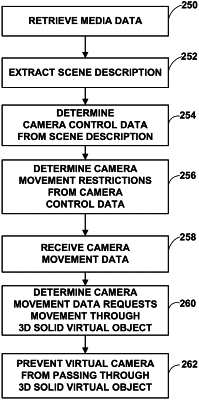| CPC H04N 13/178 (2018.05) [G06T 13/40 (2013.01); G06T 17/10 (2013.01); G06T 17/20 (2013.01); H04N 5/2224 (2013.01); H04N 13/117 (2018.05); H04N 13/275 (2018.05); G06T 2210/12 (2013.01); G06T 2210/21 (2013.01)] | 31 Claims |

|
1. A method of retrieving media data, the method comprising:
receiving, by a presentation engine, streamed media data representing a virtual three-dimensional (3D) scene;
receiving, by the presentation engine, an extension data structure associated with the virtual 3-D scene, the extension data structure including:
first object information comprising a vertex coordinate indicative of at least one virtual cuboid object in the virtual 3D scene, and
animation information indicative of an animation triggered based on interaction of a virtual camera with the at least one virtual cuboid object in the virtual 3D scene;
receiving, by the presentation engine, camera movement data from a user requesting that the virtual camera move through the at least one virtual cuboid object; and
using the first object information, updating, by the presentation engine, a location of the virtual camera to ensure the virtual camera remains outside of the at least one virtual cuboid object in response to the camera movement data.
|